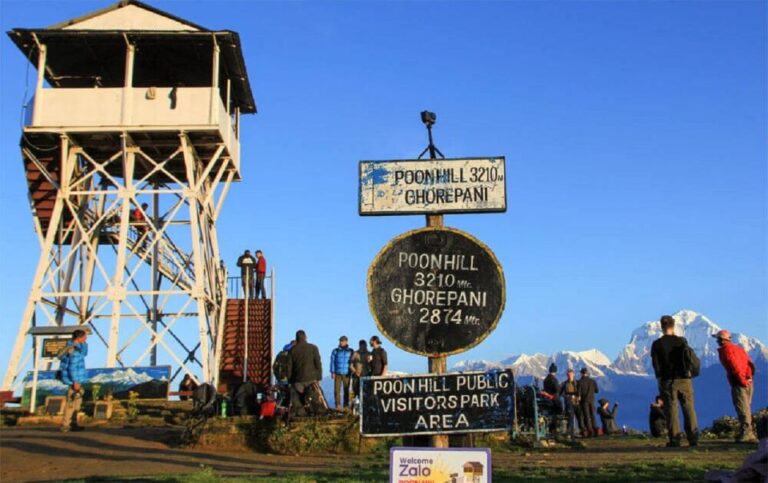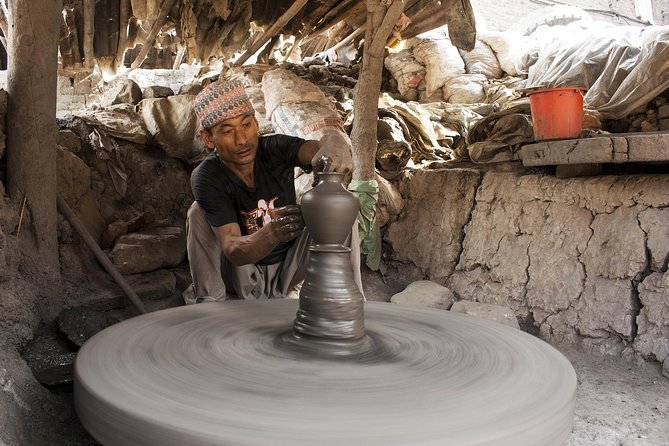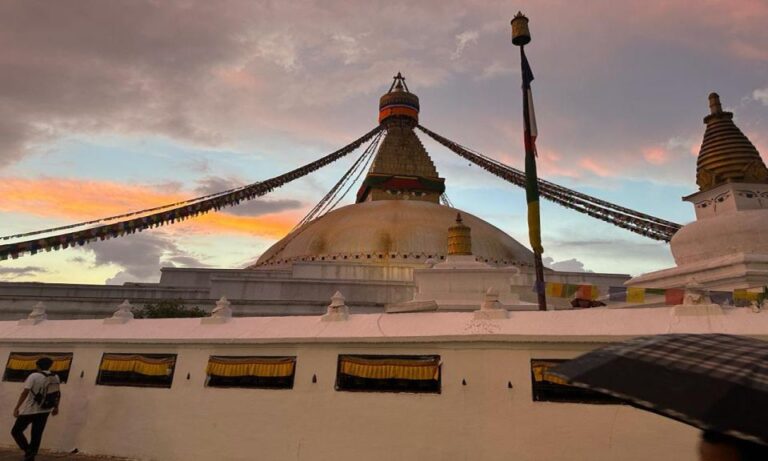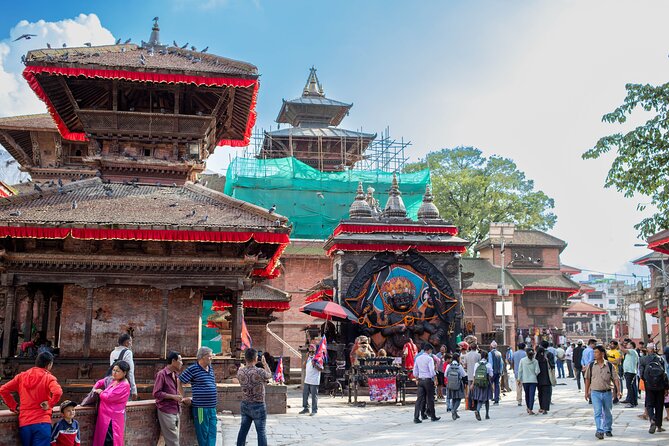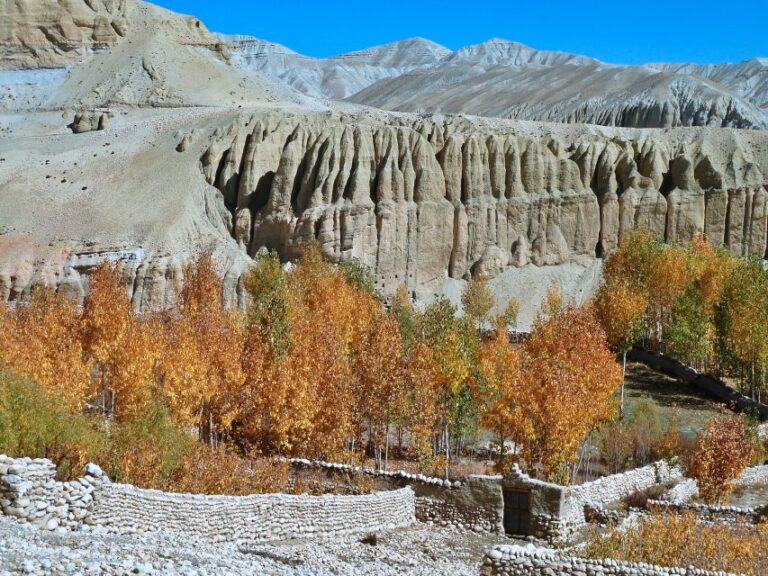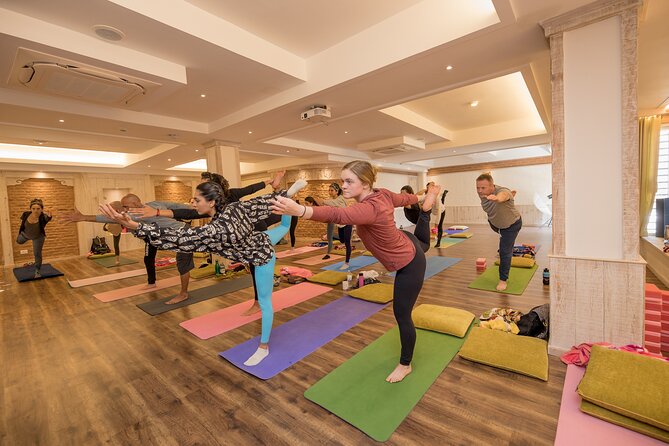12 Days Everest Base Camp Trek in Nepal
As the crisp mountain air fills their lungs, trekkers on the 12 Days Everest Base Camp Expedition in Nepal find themselves surrounded by a world where rugged peaks pierce the sky and prayer flags flutter in the wind.
The journey promises not just physical challenge, but a deep dive into the rich Sherpa culture and an intimate encounter with the towering Himalayas.
With each step, a new chapter unfolds, offering a glimpse into a realm where nature reigns supreme and personal limits are tested.
Join this expedition, and discover the transformative power of the world’s highest peak.
Just The Basics

- Acclimatization at key points like Namche Bazaar and Dingboche is vital to prevent altitude sickness.
- Proper gear, including hiking boots and medications like Diamox, ensures safety and comfort.
- Trekking itinerary covers Kathmandu to Everest Base Camp with cultural and scenic experiences.
- Unparalleled panoramic views of the Himalayas and rich culture await on this 12-day trek.
It's also worth checking out some other tours and experiences nearby.
Overview of Everest Base Camp Trek
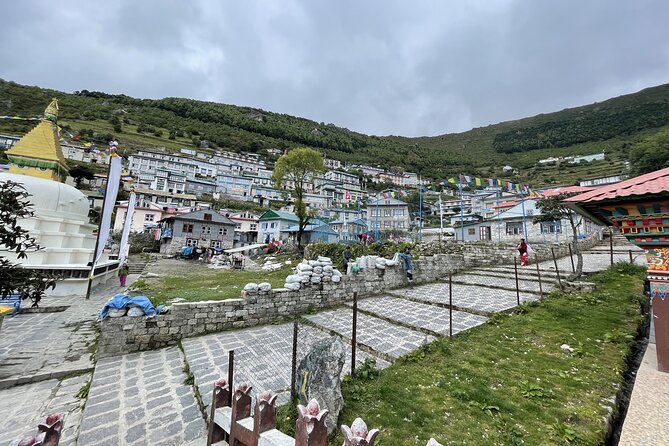
Embark on the iconic Everest Base Camp Trek in Nepal, a journey that promises breathtaking views and an unforgettable adventure through the Himalayas. As trekkers ascend to higher altitudes, altitude sickness becomes a concern. Adequate acclimatization is crucial to prevent this condition, with most itineraries incorporating rest days to help the body adjust.
The trek offers unparalleled scenic views, providing ample photography opportunities along the way. From towering snow-capped peaks to picturesque valleys, every step offers a new perspective of the stunning landscape. Trekkers should be prepared not only for the physical challenge but also to be immersed in the beauty of nature that surrounds them, making every moment on this trek a truly memorable experience.
Preparation and Packing List
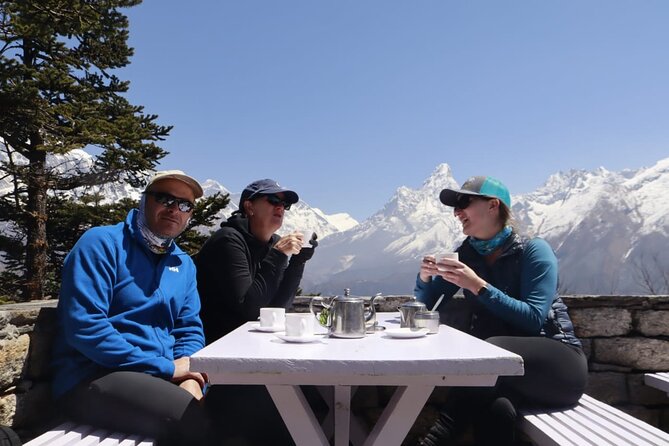
When preparing for the Everest Base Camp Trek in Nepal, it’s essential to carefully plan and pack all necessary gear and supplies to ensure a safe and enjoyable journey through the Himalayas.
Some packing essentials include a sturdy pair of hiking boots, moisture-wicking clothing, a warm sleeping bag, high SPF sunscreen, lip balm, and a refillable water bottle to stay hydrated.
Plus, it’s crucial to pack medications for altitude sickness prevention, such as Diamox, and familiarize oneself with the symptoms of altitude sickness.
Being prepared with the right gear and supplies won’t only enhance the trekking experience but also contribute to the overall safety and well-being of the trekkers amidst the challenging terrain and high altitudes.
Day 1: Arrival in Kathmandu
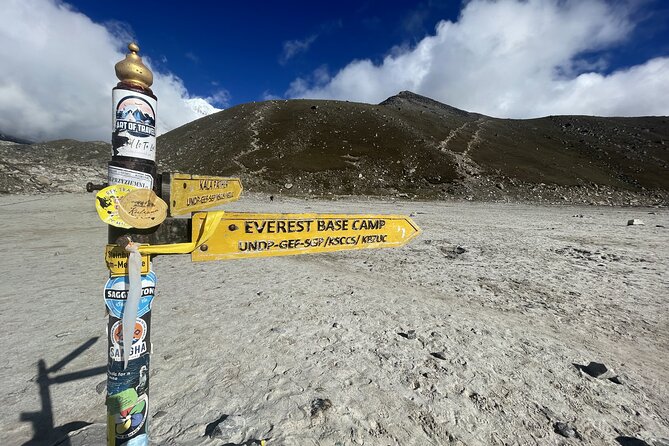
Upon arriving in Kathmandu for the Everest Base Camp Trek in Nepal, travelers are greeted by the vibrant sights and sounds of the bustling city, setting the stage for an exciting adventure ahead.
-
Exploring Kathmandu: Travelers can wander through the narrow streets of Thamel, filled with colorful shops and bustling markets.
-
Cultural Immersion: Enjoy the rich cultural heritage of Kathmandu by visiting ancient temples like Swayambhunath, also known as the Monkey Temple.
-
Local Cuisine: Indulge in delicious Nepalese dishes like momos (dumplings) and dal bhat (lentils and rice) to experience the flavors of the region.
These experiences will provide a taste of the vibrant culture and warm hospitality that awaits on the journey to Everest Base Camp.
Day 2: Flight to Lukla and Trek to Phakding

Arriving in Lukla by a scenic flight from Kathmandu, trekkers are greeted by breathtaking views of the Himalayas before setting off on the exhilarating journey towards Phakding.
The flight experience itself is an adventure, with small planes navigating through the mountainous terrain, offering passengers a unique perspective of the landscape below.
Upon reaching Lukla, trekkers can choose from a variety of accommodation options in Phakding, ranging from cozy teahouses to more comfortable lodges. These accommodations provide a much-needed rest after the day’s trek, offering warm meals and a chance to recharge before continuing the trek towards Everest Base Camp.
The accommodations also allow trekkers to interact with fellow hikers, sharing stories and experiences from their journey.
Day 3: Trek to Namche Bazaar
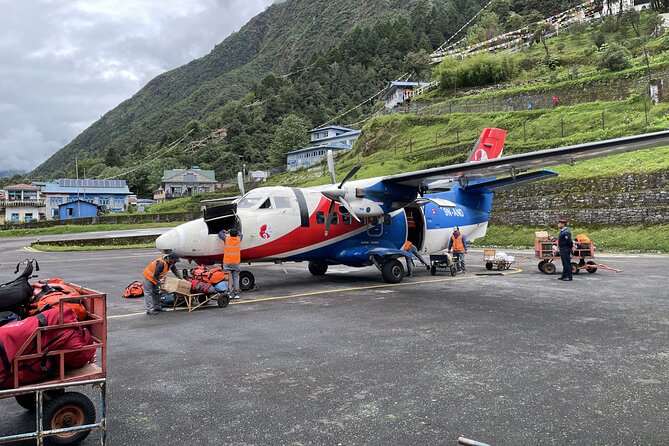
Embarking on the trek to Namche Bazaar on Day 3 offers trekkers a challenging yet rewarding journey through the stunning Himalayan landscape. The trail presents various trekking challenges, including steep ascents and rugged terrain, testing the endurance and determination of adventurers.
Along the way, hikers are immersed in the rich tapestry of local culture, encountering traditional Sherpa villages and gaining insights into their way of life. The vibrant prayer flags fluttering in the mountain breeze and the distant sound of chanting from monasteries add to the spiritual ambiance of the trek.
As trekkers push themselves through the demanding path, they’re rewarded not only with breathtaking mountain views but also with a deeper appreciation for the Himalayan region’s unique heritage.
Day 4: Acclimatization Day in Namche Bazaar
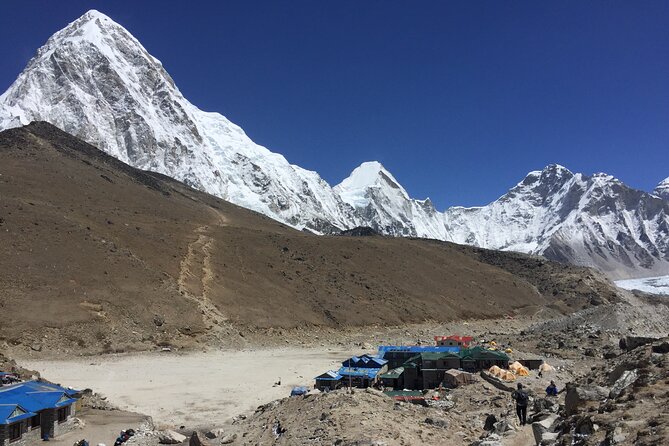
Trekking enthusiasts in Namche Bazaar on Day 4 take a well-deserved break to acclimatize to the high altitude conditions, allowing their bodies to adjust gradually for the upcoming challenges of the journey ahead. Acclimatization benefits include reducing the risk of altitude sickness, a common issue faced by many trekkers.
By resting and giving their bodies time to adapt to the thin air and lower oxygen levels, hikers can prevent altitude-related illnesses. This day of rest in Namche Bazaar is crucial for ensuring that the trekkers are physically prepared for the higher altitudes they’ll encounter as they continue their journey towards Everest Base Camp.
Proper acclimatization is key to a successful and safe trekking experience in the Himalayas.
Day 5: Trek to Tengboche
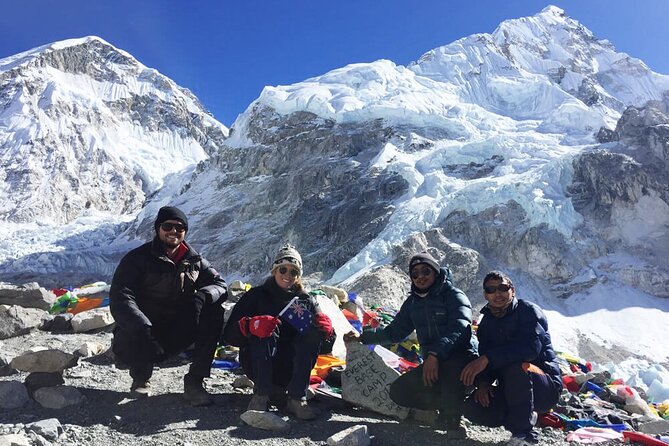
On Day 5 of the Everest Base Camp trek in Nepal, travelers make their way towards Tengboche, a picturesque village known for its stunning monastery and breathtaking mountain views. Along the trek, they encounter:
- Tea houses: Providing warm beverages and a cozy resting place for trekkers.
- Buddhism: Immerse in the spiritual ambiance with prayer flags fluttering in the wind.
- Mountain views, Tengboche Monastery: Enjoy panoramic views of the Himalayas and visit the famous Tengboche Monastery, a significant Buddhist site.
After a day of trekking through the awe-inspiring landscapes, reaching Tengboche offers a peaceful retreat amidst the grandeur of nature and cultural richness.
Day 6: Trek to Dingboche
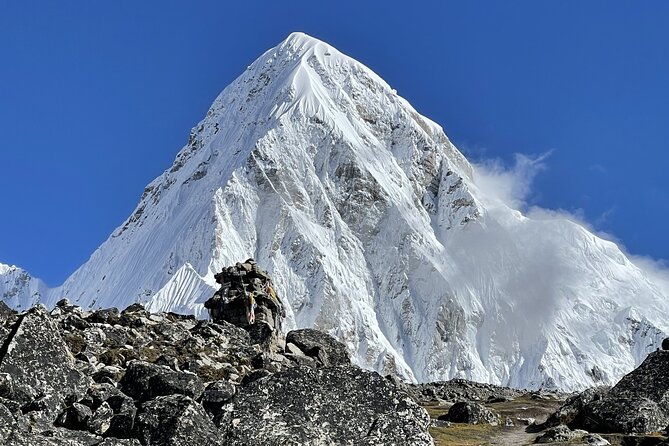
Heading towards Dingboche on Day 6 of the trek, travelers will encounter a landscape rich with alpine beauty and cultural wonders awaiting exploration. This leg of the journey involves navigating higher altitudes, making it crucial for trekkers to focus on acclimatization to prevent altitude sickness.
The high altitude trekking offers stunning panoramic mountain views, with peaks like Ama Dablam and Lhotse becoming more prominent as hikers ascend. As the trek progresses, the air becomes thinner, requiring slower movements to adapt to the reduced oxygen levels.
It’s essential for adventurers to listen to their bodies, stay hydrated, and take necessary breaks to allow for proper acclimatization. The trek to Dingboche isn’t just a physical challenge but also an opportunity to take in the raw beauty of the Himalayas.
Day 7: Acclimatization Day in Dingboche
Day 7 in Dingboche invites travelers to embrace the tranquil surroundings and focus on acclimatizing to the high altitude environment. Exploring Dingboche offers a unique experience to explore the local culture and witness the beauty of the Himalayas.
The day serves as a crucial period for trekkers to adapt to the altitude challenges before continuing their journey towards Everest Base Camp. Strolling around Dingboche village allows visitors to interact with the locals and gain insights into their way of life.
Taking this time to rest and acclimatize not only enhances the trekking experience but also ensures the well-being of all adventurers. Enjoy the peaceful atmosphere and learn about the rich culture of Dingboche.
Day 8: Trek to Lobuche
After acclimatizing in Dingboche, trekkers set out on their journey to Lobuche, a picturesque village nestled in the Himalayas. The trek to Lobuche presents various challenges, including steep ascents and rocky terrain. As trekkers ascend further, altitude effects become more pronounced. It’s crucial for trekkers to stay hydrated, maintain a steady pace, and listen to their bodies to prevent altitude sickness.
The surrounding mountain views provide a stunning backdrop, motivating trekkers to push through the difficulties. Despite the physical demands, the sense of accomplishment upon reaching Lobuche is immense. Trekkers are rewarded with breathtaking panoramic views and a sense of awe at the sheer magnitude of the mountains surrounding them.
Day 9: Trek to Everest Base Camp and Gorak Shep
Ascending from Lobuche, trekkers embark on a challenging journey towards Everest Base Camp and Gorak Shep, navigating through rugged terrain and increasing altitude effects. The trekking challenges intensify as the air thins, making each step more strenuous yet rewarding with breathtaking high altitude views.
- Trek through rocky paths and icy patches
- Experience the gradual decrease in oxygen levels
- Witness the majestic Himalayan peaks looming in the distance
The arduous ascent to Everest Base Camp and Gorak Shep tests both physical endurance and mental resilience, but the awe-inspiring panoramas of the surrounding mountains make every struggle worthwhile. The sense of accomplishment that comes with reaching these iconic destinations is unparalleled, making the journey truly unforgettable.
Day 10: Trek to Kala Patthar and Return to Lukla
Navigating through the rugged terrain of the Himalayas, trekkers on this leg of the journey are met with a challenging yet rewarding ascent towards Kala Patthar and the eventual return to Lukla. As trekkers reach Kala Patthar, they are greeted with breathtaking sunset views, offering unparalleled photography opportunities to capture the beauty of the Everest region. However, at this high altitude, altitude sickness becomes a concern. Trekkers must adhere to safety precautions, such as staying hydrated, ascending slowly, and recognizing the signs of altitude sickness promptly. It’s crucial to prioritize safety while enjoying the stunning vistas that Kala Patthar has to offer. Below is a table summarizing safety precautions for altitude sickness:
| Safety Precautions for Altitude Sickness |
|---|
| 1. Stay hydrated |
| 2. Ascend slowly |
| 3. Recognize signs of altitude sickness |
Here's a few more nearby tours and experiences we think you'll like.
Frequently Asked Questions
Is There Wi-Fi Available Along the Trekking Route to Everest Base Camp?
Yes, there is limited Wi-Fi connectivity along the trekking route to Everest Base Camp. Communication options include using local teahouses that offer intermittent internet access. It’s advisable to have alternative methods like satellite phones for reliable communication.
Are There Any Souvenir Shops or Markets Where We Can Buy Local Handicrafts During the Trek?
Yes, there are several souvenir shops and markets along the trekking route selling local crafts. You can enjoy souvenir hunting and find unique handmade items like traditional clothing, jewelry, and handicrafts to take home.
What Is the Availability of Medical Facilities or Pharmacies in Case of Emergencies During the Trek?
In case of emergencies during the trek, medical facilities and pharmacies may be limited due to the remote location and high altitude. Altitude sickness and the need for emergency evacuation are important considerations when planning for safety.
Are There Any Cultural Events or Festivals That We Might Encounter During the Trekking Period?
During the trekking period, trekkers may encounter traditional dances, rituals, and local cuisine customs. Nepal’s diverse culture often leads to vibrant celebrations and festivals that add a unique and enriching experience to the journey.
Can We Expect to See Wildlife Such as Yaks or Mountain Goats Along the Trek to Everest Base Camp?
Travelers can expect exciting wildlife encounters like yaks and mountain goats along the trek to Everest Base Camp, offering fantastic photography opportunities. These animals thrive in their natural habitat, showcasing conservation efforts in the region.
Not for you? Here's more of our most recent tour reviews happening neaby
- Upper Mustang Trekking – 15 Days
- Everest Helicopter Tour: Experience the Ultimate Aerial Adventure of a Lifetime
- 12 Days Annapurna Circuit Trek
- Private Half-Day Off-Road Safari in Shivapuri-Nagarjun Park – Kathmandu
- Nepal Multisport Adventure Tour
- 7 Days Honeymoon Tour in Nepal
- Nepal Cultural & Adventure
- Bandipur Homestay Tour
- Tibet Tour With Everest Base Camp – FLY IN DRIVE OUT- 8 DAYS
- Day Hiking Near Kathmandu Valley.
- 4 Days Langtang Valley Short Trek
- Lobuche East Peak Climb With Everest Base Camp Trek
- 4-Day Kathmandu Valley UNESCO World Heritage Sites Tour
- UNESCO World Heritage Site Tour in Kathmandu
- Private One-Day Hike From Kathmandu: Shivapuri National Park
Final Words
Embarking on the 12-day Everest Base Camp trek in Nepal is an unforgettable adventure that offers breathtaking landscapes, rich cultural experiences, and a sense of accomplishment like no other.
From the bustling streets of Kathmandu to the serene mountain villages and towering peaks of the Himalayas, every step of the journey is filled with wonder and discovery.
This trek promises to create memories that will last a lifetime and leave you with a deep appreciation for the beauty of nature and the spirit of adventure.
